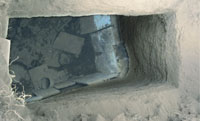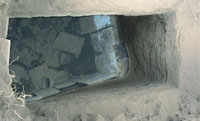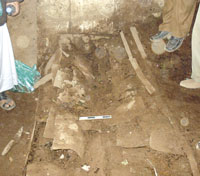
Money dispute destroys new historical finding [Archives:2008/1122/Last Page]
January 21 2008
 |
 |
 |
hamed_thabit@hotmail.com
On Wednesday, Jan. 16, a group of around 80 to 100 unaffiliated tribal members went to Al-Asebiah area in Ibb's Al-Sada'a district with machine guns to fight security forces in order to take control of a royal ancient grave recently discovered in the area. According to Khalid Al-Ansi, director of Ibb's General Authority for Antiquities and Museums, locals were angry that antiques found at the site were sent to Dhofar's museum and the tribesmen wanted their antiques returned. “In fact, tribes wanted to take whatever they could from the grave,” he claimed.
The tribesmen were divided into two groups, one of which fought with the soldiers while the other entered the grave in order to take whatever they could. In the process, they destroyed everything, including a bronze coffin, in their apparent search for gold.
The small army detachment at the site could not stop the tribes and surrendered. Nabil Al-Awathi, the head district director in Al-Sada'a, confirmed that most of the soldiers assigned to guard the grave received orders to leave the site due to an urgent matter nearby, resulting in only one sentry car instead of four, facilitating the tribal operation's success.
Al-Awathi added that some of the tribesmen who looted the grave were discovered, arrested and requested to return anything they stole. However, many of the culprits are still unknown.
Government learns about tomb
Following these events, government officials came to know about the tomb, however only to learn that it had been looted for almost a year by local tribes.
The looting had reached a point where officials warned that a war might start between two tribes of Ezla'a Wadi Essam and Ezla'a Al-Jabel in Al-Asebiah because both claimed ownership of the ancient grave site.
Following these events, the government assigned a security force to guard the site and fenced off the area. “If the two tribes hadn't prepared to fight each other, we would not have known about the grave,” he commented.
One bronze coffin was found in the grave and studies suggested there might be another coffin. Recent studies by experts claimed the coffin pointed to a royal grave. Experts noted that it might have been for a king and his wife, or for a queen, as there are all kinds of women's articles and materials made of gold.
Moreover, experts mentioned this was the first time such a grave was found in the area. In order to access the grave, a hole 4-5 meters deep had to be dug. The tomb walls were built of marble, while the floor was paved with tiles and bronze.
In addition to the bronze coffin destroyed by locals, the grave was full of gold; the government found 2 kilograms of gold and many vases made of bronze, as well as a sword with a gold handle.
Local council member Ibrahim Al-Ashwal, who was at the scene, noted that locals who started digging the grave found the gold artifacts, some of which were returned and placed in Dhofar's museum, while most remain with the locals.
Recently there were about 16 Yemeni experts in the site studying the grave. “But after the shooting, the excavation was stopped till we receive more money and security from the government. We asked the government to provide us with a military guard,” said Al-Ashwal.
Al-Werafi, confirmed, “We cannot resume studies because the place is not safe. And in any minute another problem might happen by tribes. So we are waiting for more support from the government in order to protect the place. In fact, this tomb still has undiscovered artifacts and we cannot work while tribes are making problems. However, the government agreed to our demands and we are waiting.”
Al-Ansi expressed, “Some of the locals gave us more than 15 antiques, including a statue made of gypsum and bronze. Also, many other pieces of gold sculptured were sent to the museum. Many of the statues are in bad condition.”
Moreover, after the incident security increased. Al-Awathi noted, “We asked the government to be serious about providing security in order for us to conduct studies more efficiently and also to save the tomb from destruction. This tomb was discovered for the first time in the area and attention must be given to it.'
Looting and smuggling is still a problem
Dr. Abud Al-Rahaman Jar Allah, the Deputy of Museums in the Antiquities General Assembly, noted that according to the law related to antiques before its amendment, “Anyone convicted of smuggling antiques or trading with them will receive a 2-5 year imprisonment sentence, which is not enough to frighten anyone who smuggles antiques.” However, the new antiques law has not been published yet.
Jar Allah noted that locals are making problems and want the grave to be given to them because it is in their area. Also he went to say that “locals say they do not trust the government and are not sure that these antiques will be in a safe place or not. That is why they want it for themselves. But in fact this demand was only an excuse for them to take the antiques for themselves.”
Al-Ansi said local citizens should coordinate with government authorities and help reduce the problem of smuggling.
Ahmed Shoja'a, general manager of Museums in the Antiquities General Assembly, noted that it is important to encourage and reward people who hand over antiques to museums. \”Those people who come to us with antiques they find through organized searching must be rewarded for handing them over to the authorities. The prize can be evaluated according to the value of each antique. However


